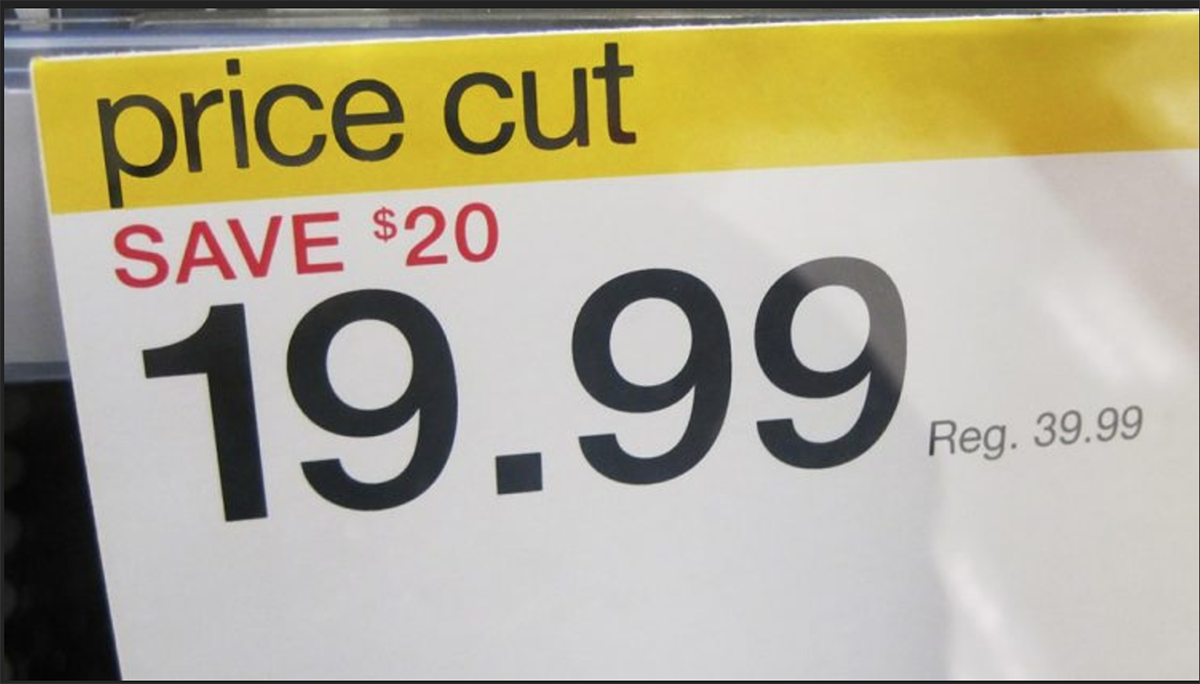
Number 9, number 9, number 9…
(Yes, yet another song reference. This time from The Beatles’ White Album.)
The “9s” Phenomenon in Pricing
When did marketers collectively decide that prices ending in 9 are more appealing? Why does $99.99 feel less expensive than $100?
Rationally, we know it’s only a penny’s difference, but research shows this tactic, known as “charm pricing,” creates the perception of a better deal.
This strategy takes advantage of a psychological principle called the” left-digit effect.” It turns out our brains fixate on the leftmost digit when evaluating numbers. In other words, our perception of a price is anchored to that initial number — making $99.99 feel like $90-something rather than a “whopping” $100.
Over 60% of retail prices end in the digit 9, according to research from Rutgers University. This isn’t random; it’s an intentional strategy. This research is found in the 1999 Journal of Retailing article, “Increased Consumer Sales Response Through Use of 99-Ending Prices.”
A classic study in the Journal of Consumer Research demonstrated that products priced at $39 sold better than the same products priced at $40. Why? Charm pricing signals to consumers that they’re getting a bargain, even if the actual difference is negligible.
And it doesn’t end there.
Charm pricing is so effective that, in one experiment, women’s clothing priced at $39 significantly outsold the same items priced at $34 — even though the latter was cheaper. That’s the power of the “9.”
To have a deeper dive into why this strategy works, read this 1999 Journal of Retailing article, “Increased Consumer Sales Response Through Use of 99-Ending Prices.”
My Personal Pushback
Whenever a salesperson tells me a product costs $19.99, I like to counterplay, “Oh, $20.” This usually earns a sheepish nod or a correction: “No, it’s $19.99.” My response? “Yes, $20. Got it.”
I find this exercise amusing — even empowering. It’s my small rebellion against a pricing strategy I see as borderline deceptive. Sure, it’s deeply ingrained in consumer culture, but that doesn’t mean we have to buy into the illusion.
Is Charm Pricing Deceptive?
How do you feel about the “9s” pricing strategy? Have you grown so accustomed to it that it barely registers anymore?
Or, like me, does it come off as a little patronizing? While the strategy isn’t overtly dishonest, it does manipulate perceptions in a way that feels, well, sneaky.
The Reality of “9s” Pricing
The truth? Charm pricing is here to stay. If one company rounds its prices to whole numbers while competitors stick to “9s,” the latter may win more sales. It’s too deeply rooted in consumer psychology and marketing strategy to disappear.
But as savvy consumers, we can push back. Mentally round up when you see $9.99 — it’s $10. A $499 price tag? Think $500. By recognizing the tactic, you can take back control over how prices affect your decisions.
The Big Takeaways
- Charm pricing works: By leveraging the left-digit effect, marketers can boost sales, even with negligible price differences.
- Understanding the strategy is power: Being aware of charm pricing helps you shop with clarity and intention.
- Stand your ground: Mentally round up and resist the psychological pull of the “9.”
Let’s not forget: integrity in marketing extends beyond pricing. Transparency — whether in pricing strategies or unsubscribe links — builds trust and sets brands apart.
What’s your take on charm pricing? Does it bother you, or do you shrug it off? Let’s chat!

Jeffery E. Pizzino, APR is a spin-free public relations pro who is passionate about telling the why of your story with clarity, impact and authenticity. He began his PR career in 1987 at Ketchum Public Relations in New York City but has spent the majority of his career as a solopreneur. He’s AuthenticityPR’s Chief Authentic Officer and also functions as the fractional CCO for technology startup Converus.
Jeff has an MBA in Management from Western International University and a Bachelor of Arts degree in Communications — with an emphasis in PR — from Brigham Young University. He’s a native of Milwaukee, Wisconsin, but also holds an Italian citizenship. Jeff and his storyteller wife Leticia have four children and four grandchildren. In his extremely limited nonwork hours, he studies italiano, practices guitar, gardens, disc golfs, reads, listens to New Wave music, serves in his church, watches BYU football, and plays Dominion and Seven Wonders. Email Jeff.

